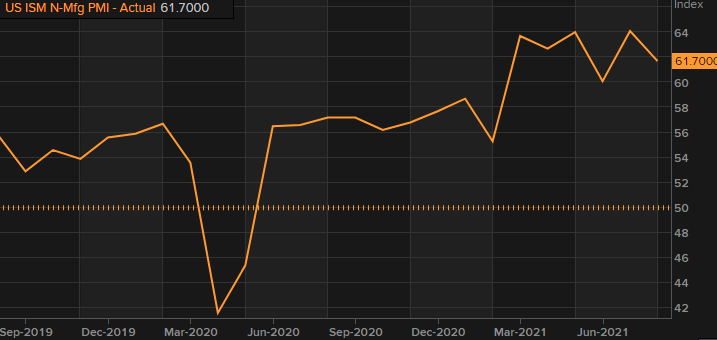US service sector data from the ISM

- Prior was 61.7
- Employment 53.0 vs 53.7 prior
- New orders 63.5 vs 63.2 prior
- Prices paid 77.5 vs 75.4 prior
- Business activity 62.3 vs 60.1 prior
- Backlog of orders 61.9 vs 61.3 prior
- New export orders 59.5 vs 60.6 prior
- Imports 47.7 vs 48.7 prior
- Inventories 46.1 vs 46.9 prior
Inventories continue to contract, similarly to manufacturing. The build up of unfinished work is growing, largely due to a lack of workers. So while that might point to slower growth now, it means that growth will remain higher for longer.
Overall this is a positive surprise and that's further boosted stocks and Treasury yields. Commodity currencies have recouped the dip from about an hour ago.
- "Transportation bottlenecks are increasing, resulting in longer lead times and missed appointments." [Accommodation & Food Services]
- "Constraints on logistics from a cost and availability standpoint continue to be an issue." [Construction]
- "Lead times on electronics and computer chips have greatly increased. Outlook for higher education remains flat for most colleges, not including elite and Ivy League institutions." [Educational Services]
- "International and domestic demand remains very strong." [Finance & Insurance]
- "Retaining clinical and temporary staffing is critical at this time. With the Delta variant's spread, we continue to see increased (COVID-19) cases, but not as bad as January 2021. Vaccinations are clearly working. Most inpatient hospitalizations are of unvaccinated patients. The supply chain is still being impacted significantly by increased lead times for equipment and supplies." [Health Care & Social Assistance]
- "The semiconductor (shortage is) impacting server delivery. Alternate parts and engineering efforts are being used to create workaround solutions." [Information]
- "Both domestic and international logistics are increasing lead times about six weeks for ocean freight and two weeks for domestic freight." [Management of Companies & Support Services]
- "Inventories shrinking due to global shipping logistics being a seller's/provider's market, with primary focus on yield versus market expansion." [Professional, Scientific & Technical Services]
- "Lead times have improved slightly over the last period, but still remain lengthy relative to pre-pandemic levels. We continue to see rising costs for both supply and service inputs. The effects of these price increases have the potential to significantly impact our operations through the end of the year, especially if seasonal trends prove exceptionally strong." [Public Administration]
- "Business volumes remain remarkably high, although material shortages persist." [Real Estate, Rental & Leasing]
- "Still experiencing very strong demand. Supply chain is still a challenge." [Retail Trade]
- "Demand far outweighs supply for goods and services." [Transportation & Warehousing]
- "We continue to deal with extended delivery lead times and high costs. Stress on the supply chain beginning to be reflected in the quality of products offered and delivered. Current buying strategy is to wait - except with equipment, as (price) increases are expected." [Utilities]
- "Continued constrained supply of many key product groups. Also, inflationary pressures in most areas of the business keep driving costs higher. Inconsistent COVID-19 restrictions throughout the country are creating unstable business conditions that are concerning. However, business continues to be strong overall." [Wholesale Trade]
The bolded is informative because it speaks to inflation expectations. If you expect prices to continue rising, you buy anyway. If you think they're going to come back down, you wait. However it's interesting to note that price inflation is becoming embedded in equipment (at least in the utilities sector).



